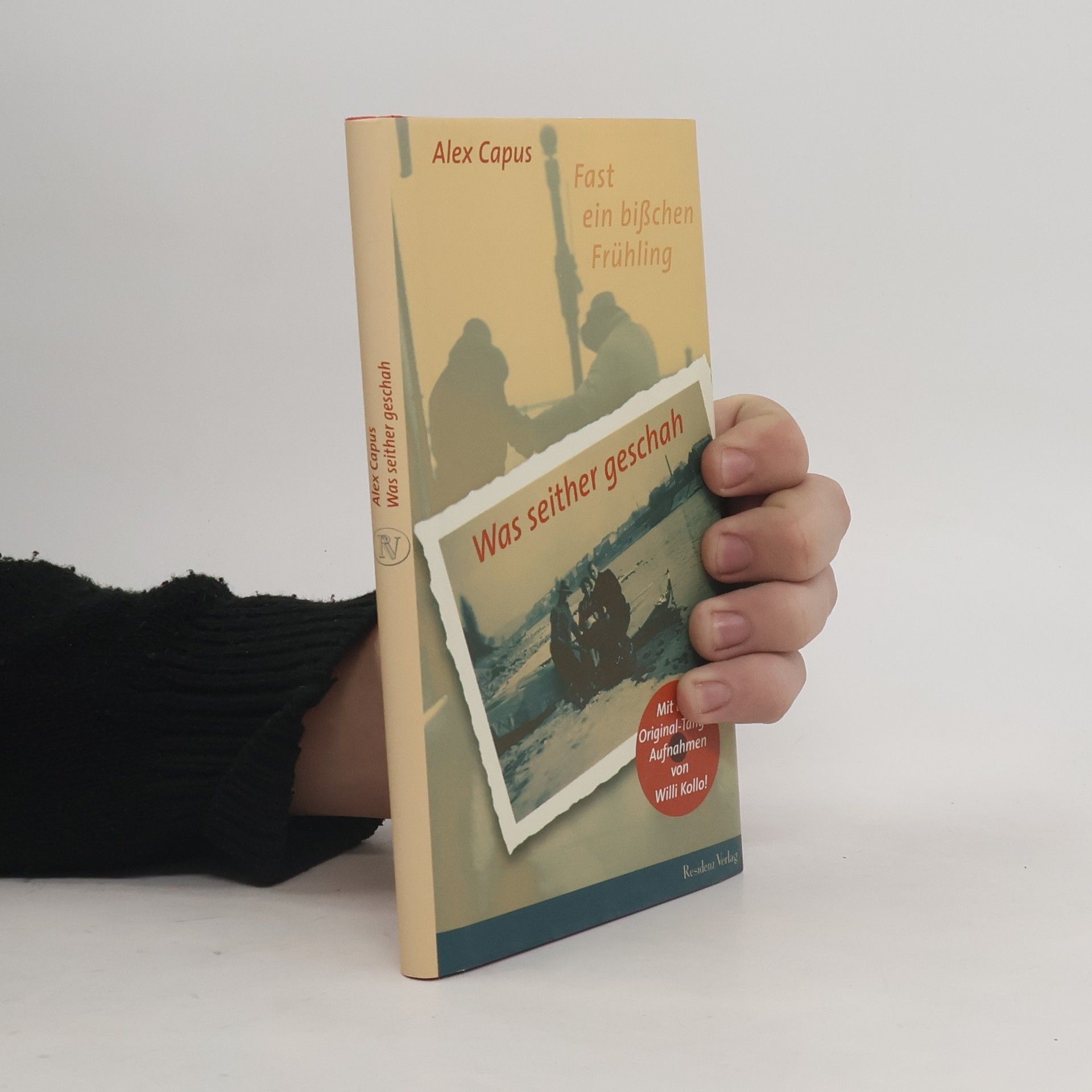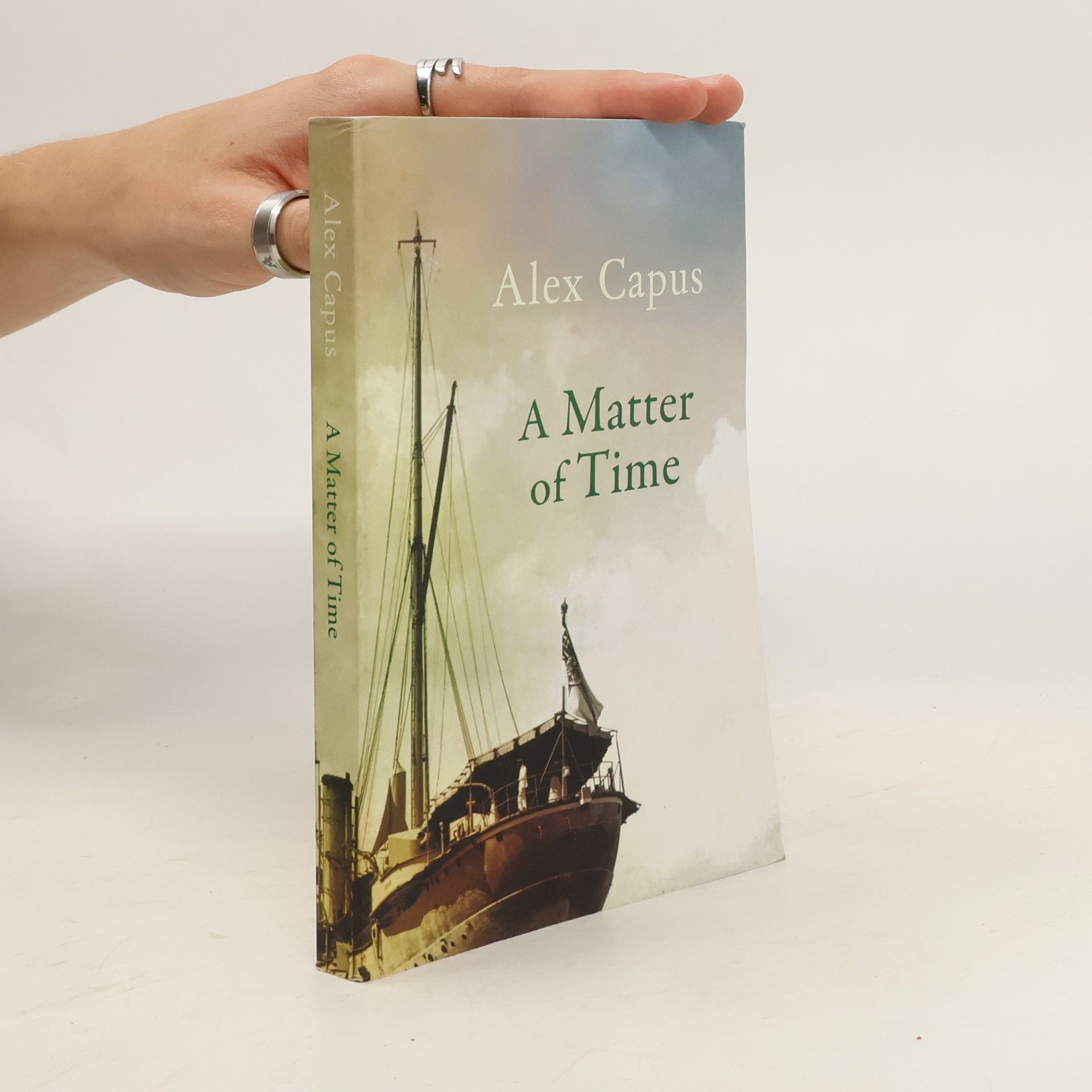Léon et Louise n’ont pas vingt ans lorsqu’ils se rencontrent dans un petit village français vers la fin de la Première Guerre mondiale. Bientôt perdus de vue, séparés par les hasards de l’Histoire et les vents contraires du destin, les deux jeunes gens ne s’oublieront jamais. En explorant la vie secrète de son propre grand-père sur plus de quarante ans, Alex Capus signe le roman d’un amour plus fort que le tourbillon de la vie, une épopée intime irrésistible.
Alex Capus Livres







A Matter of Time
- 256pages
- 9 heures de lecture
In 1913, three German shipbuilders were ordered to reassemble a steam ship on Lake Tanganyika. At the same time, Winston Churchill sends Commander Geoffrey Spicer-Simson to transport two dilapidated and incongruously named gun-boats, Mimi and Toutou, to the other side of the lake. Then World War I breaks out as the two sides are facing each other.
Almost like spring
- 149pages
- 6 heures de lecture
With brilliantly vivid irony, a mosaic of voices tells the true story of Switzerland's most notorious bank robbers: Kurt Sandweg and Waldemar Velte. As 1933 draws to a close, the pair arrive in Basel from Wuppertal, Germany. Rebels on the run, they are searching for an escape from the confines of a callously regimented society left impoverished by the Depression and the onset of Nazi power. However, their desperation leads them to a realm outside reality, on a destructive path of vengeance for the world's abhorrent lack of justice. Resolute on their doomed mission, neither expected to fall in love. Seen through the benign eyes of Dorly Schupp, the agonising humanity of their relationships are sharply juxtaposed against the reckless cruelty of their crimes. Yet in a world equally heartless and unremitting, who should shoulder the blame? Capus relates the portrait of these chillingly charismatic figures in a curious blend of documentary and narrative where precision of detail collides with an economy of emotion, and leaves the desolation of their situation stark and blindingly poignant. Suspended between the tragic and comic, Capus's novel mimics the absurd idiosyncrasies of life where often nothing but interpretation is left to determine the sacred from the profane.
Mit Krakenarmen greift die Vergangenheit nach mir, seit ich die wahre Geschichte aufgezeichnet habe von Dorli Schupp, Waldemar Velte und Kurt Sandweg. (Alex Capus)
Als Max und Tina in ihrem Auto eingeschneit auf einem Alpenpass ausharren müssen, erzählt Max eine Geschichte, die genau dort in den Bergen, zur Zeit der Französischen Revolution, ihren Anfang nimmt. Jakob ist ein Knecht aus dem Greyerzerland. Als er sich in Marie, die Tochter eines reichen Bauern, verliebt, ist dieser entsetzt. Er schickt den Jungen erst in den Kriegsdienst, später als Hirte an den Hof Ludwigs XVI. Dort ist man so gerührt von Jakobs Unglück, dass man auch Marie nach Versailles holen lässt. Meisterhaft verwebt Alex Capus das Abenteuer des armen Kuhhirten und der reichen Bauerntochter mit Max' und Tinas Nacht in den Bergen. Ein hinreißendes Spiel zwischen den Jahrhunderten. Alex Capus' schönste Liebesgeschichte seit „Leon und Louise“.
Die fünf kurzen Erzählungen „Etwas sehr, sehr Schönes“, „Sommeridyll 1“, „Der weiße Tennisball“, „Wer zum Teufel ist Ramón“ und „Roxy“ lassen die Schweizer Kleinstadt Olten zum Mittelpunkt der Welt werden. Mal mit leiser Wehmut, mal mit bissiger Ironie erzählt er von den kleinen Dingen des Alltags, die plötzlich folgenreiche Veränderungen auslösen können und entfaltet einen Bilderbogen über das Leben um die Dreißig.
Die Frage, ob die Schatzinsel aus Robert Louis Stevensons berühmtem Roman tatsächlich existiert, beschäftigt bis heute viele Leser und Schatzsucher. Alex Capus, ein hochgelobter Schweizer Erzähler, enthüllt in seinem Buch 'Reisen im Licht der Sterne' ein gut gehütetes Geheimnis der Weltliteratur. Am 7. Dezember 1889 landeten in Apia drei Europäer, darunter der kranke Stevenson, der wegen seiner Lungenkrankheit dem Tod näher war. Sein geplanter kurzer Aufenthalt wurde zur letzten Lebensstation, wo er fünf Jahre in einem Klima lebte, das seiner Gesundheit schadete, und familiären Konflikten ausgesetzt war, da seine Frau Fanny und deren Kinder das Leben auf Samoa verabscheuten. Capus erkundet mit der Begeisterung eines Schatzsuchers und der Kombinationsgabe eines Forschers Stevensons Leben, verknüpft Legende und Wahrheit über die Insel der Piratenschätze und zeigt Stevenson als Abkömmling eines schottischen Clans und als schwerkranken Forscher. Er bietet eine überraschende Erklärung für die Misserfolge der Schatzsucher: Der Schatz ist nicht dort, wo alle suchen, sondern wo Stevenson es wusste.
Im Zentrum der raffiniert verwobenen Geschichten steht Max Mohn, der widerwillig eine Karriere im Fernsehen einschlägt. Seine Ehefrau Ingrid, in die er bereits als Dreizehnjähriger verliebt war, wird er dennoch verlieren. Zudem gibt es den dauerschlafenden Großvater, der aus Trotz und Geiz nicht sterben will, und Johnny Türler, einen gescheiterten Abenteurer, der in der väterlichen Konditorei Pralinen verkauft. Kellner René harrt im leeren Bahnhofsrestaurant aus und führt in einem karierten Schulheft ein Archiv menschlichen Leidens. Die Handlung spielt in einer gewöhnlichen Kleinstadt, in der sich die Akteure kennen, lieben und hassen und lebenslang nicht voneinander loskommen. Alex Capus thematisiert die harmlosen und schlimmen Querschüsse des Lebens sowie die Launen des Glücks – mit Witz und gerechtem Zorn. Diese präzise gezeichnete Comédie humaine unserer Zeit lädt dazu ein, die Fülle an Geschichten um uns herum zu entdecken, wenn man nur richtig hinsieht. Die Erzählungen sind federleicht geschrieben und spannend zu lesen, was sie zu einer Rarität im deutschen Sprachraum macht.
»Alex Capus ist ein wunderbarer Erzähler, für den alles eine Geschichte hat, für den die Welt lesbar ist.« Süddeutsche Zeitung Wir sind im Baseler Hinterland, genauer gesagt in der Kleinstadt Olten, und mittendrin in einem Bilderbogen über das Leben der heute gut Dreißigjährigen. Es ist der Alltag mit seinen kleinen Begebenheiten, die plötzlich ereignisreiche Veränderungen auslösen, es sind die Verheißungen und Hindernisse des Glücks und unter diesen Hindernissen das fatalste, der Tod, von denen Alex Capus in neunzehn kleinen Geschichten mal mit leiser Wehmut und mal mit bissiger Ironie erzählt. Da gibt es solche in jenem besonderen Alter, die sich den Haaransatz blond nachfärben lassen, andere, die ihren Platz im Altersheim schon reserviert haben und sogar ein paar happy few, die gar den Ausbruch versuchen. Es sind, kurz gesagt, wie meist die Geschichten, die sozusagen auf der Straße liegen, die das Leb(s)en leb(s)enswert machen. Inhalt: - Etwas sehr, sehr Schönes - Sommeridyll 1 - Sommeridyll 2 - Wollene Unterhosen - Der weiße Tennisball - Das geht dich einen Dreck an - Champagner im freien Fall - Elvis - Eilige Dreifaltigkeit - Zombie City - Wer zum Teufel ist Ramón? - Der Ernst des Lebens - Eigermönchundjungfrau - Leite mich, Voyager I! - Roxy - In der Zeitmaschine - Kühle Klara - Fremde im Zug - Diese verfluchte Schwerkraft



